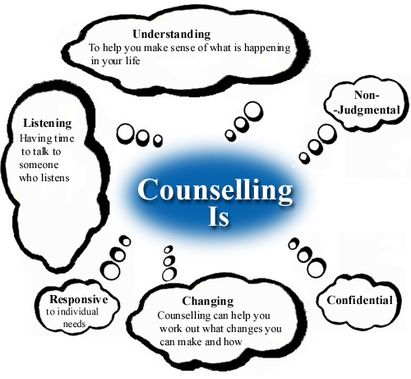|
Counselling is:
Counselling is Not:
Find more at: http://www.skillsyouneed.com/general/counselling.html#ixzz3xznrV3JG |
More about Person Centred Counselling
This humanistic approach is probably what most people imagine when they think of counselling. It's founding father, Carl Rogers, believed that we all have an in built tendency to develop and reach our full potential. However life events and experiences can negatively impact this natural process and undermine our self worth. The purpose of client-centred counselling is to create the conditions whereby the client can explore their conscious experiences and reconnect with their values and worth. The necessary conditions, according to Carl Rogers are:-
|
More about Gestalt
|
More about the Therapuetic RelationshipIn my training I was particularly influenced by Patruska Clarkson. She developed an integrative, systemic mode of the theraputic relationship which she summarised into 5 phases.
(1) The working alliance: This is the basis of the client–therapist relationship that enables both the client and the therapist to work together. This first stage is very much about building a shared understanding and a foundation, so if the relationship falters, both parties can return to the contract and try to repair the therapeutic alliance. (2) The transferential/ countertransferential relationship: This is best summarised by the common experience of meeting a person for the first time and having a strong reaction to them. This strong feeling is sometimes known as 'transference' because the person reminds us of someone from our past and we have ‘transfered’ those feelings from the past on to the the person in our present. This is relevant to both client and therapist, and why it is important for your therapist to have supervision. (3) The reparative/ developmentally needed relationship: Many clients utilise the therapists' emotional support during the personal growth that hopefully takes place during therapy. In this way the therapist may be providing support or guidance that was missing or insufficient during the clients developmental years. Given time the client begins to trust their own judgment and the need to use the therapist as an emotional support lessens, at this point therapy usually comes to an end. (4) The person-to-person relationship: This is described by the person centred model, in terms of “The 5 relationship model’ the therapist would use these conditions to facilitate the ongoing encounter with the client. The person-to-person relationship is the core or real emotional connection. (5) The transpersonal relationship This refers to the 'connection' between the therapist and client. This connection could be described as an energy, a spirit, a sense or an expansion of consciousness which can be spiritual or healing. http://counsellingtutor.com/petruska-clarkson-5-relationship-model |




